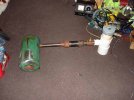- Joined
- Jun 11, 2006
- Messages
- 8,633
I have been thinking about using castable for my forge lineing because im planning to do a lot of welding in it. i am looking for a very btu iffencent lineing somthing around or under thermal conductivity of 4.0 btu-in/hr-F-ft^2. the less the better. im planning on doing a 2" thick lining on my forge leaving a 4" forge hole through the center. here is a picture of my forge so far. any comments on this or my forge is welcome. thanks

